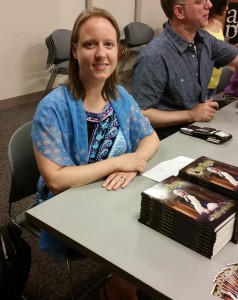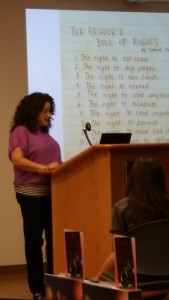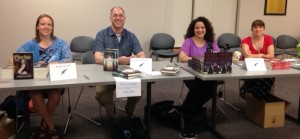Had a inspiring evening at the Avon Free Public Library’s Local Author Festival Teen/YA Night where Steven Parlato, Cindy L. Rodriguez, Anissa Zucker, and I dished on the “Reader Experience.”
 Due to an unfortunate wrong turn, my mother-in-law (who graciously kept me company during the hour-long rive to Avon) and I barely made it in time for the event. Which was important because I was the first one to speak!
Due to an unfortunate wrong turn, my mother-in-law (who graciously kept me company during the hour-long rive to Avon) and I barely made it in time for the event. Which was important because I was the first one to speak!
I discussed what I like to call the creative gap (something I’ve blogged about before here), in which I confessed that I’m a failure as a writer (I’m not really a failure…read the blog post to see what I mean). Basically, there is a gap that exists between a writer’s creative vision and what ends up on the page, a failure of the medium of the written word, but the reader is there is fill in that gap with their own imaginations. I ended my talk by reading a short excerpt from my YA fantasy ELIXIR BOUND.
by reading a short excerpt from my YA fantasy ELIXIR BOUND.
Then Steven took over with a short excerpt from his YA novel THE NAMESAKE. He shared his thoughts on writing dark material for young readers and the importance of infusing humor into it. He shared “the good, the bad, and the ugly” of what readers have said about his book.
what readers have said about his book.
Cindy, who teaches reading to middle schoolers, very eloquently spoke about reluctant readers. She included a passage from her YA novel WHEN REASON BREAKS, in which students are reading and discussing one of Emily Dickinson’s poems. She introduced us to the “Reader’s Bill of Rights” created by Daniel Pennac, which I had never heard of but will definitely be thinking about as I read and write in the future.
Finally, Anissa rounded out the evening by asking  attendees what their favorite books were growing up. She talked about how THE LITTLE PRINCE by Antoine de Saint-Exupéry what stories had a huge influence on her as a child and also when she started writing as an adult. She read from both her blog and her YA novel THE TRUE STORY OF SANTA CLAUS.
attendees what their favorite books were growing up. She talked about how THE LITTLE PRINCE by Antoine de Saint-Exupéry what stories had a huge influence on her as a child and also when she started writing as an adult. She read from both her blog and her YA novel THE TRUE STORY OF SANTA CLAUS.
Then we had time to hang out, sign books, and talk with attendees. I caught up with a few new writer friends I connected with at the New England SCBWI Conference in April, and found out that one of them who attended my revision workshop has brought the techniques I taught back to her writing group (yay!). I also sold a few books (another yay!) and talked with a few new readers.

The librarians at the Avon Library were so super organized that all us authors had to concentrate on was our presentations, and I think we nailed it. The librarians said they were going to tell the authors in the other groups that we held the audience captive and were the group to beat. Thanks so much to librarians Tina Panik and Cyndi Larsen and to my fellow authors for an amazing evening!



















